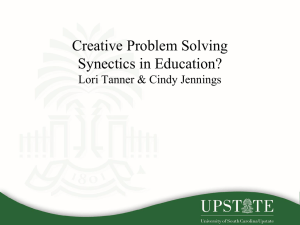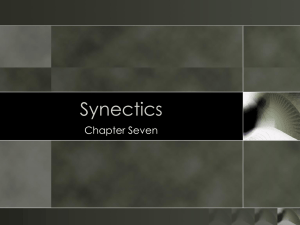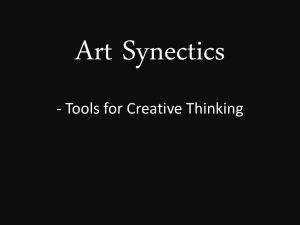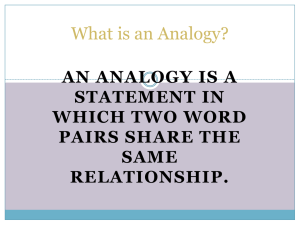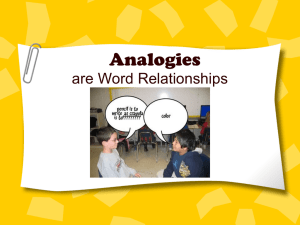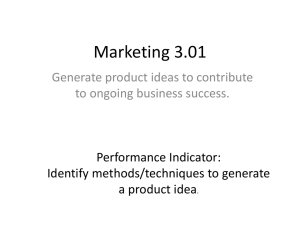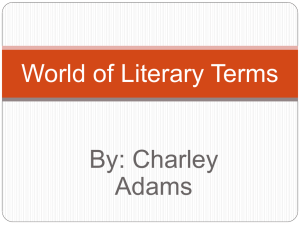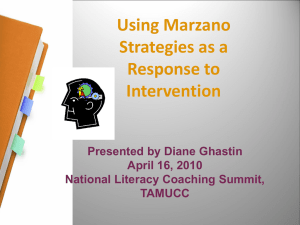Metacognition Powerpoint
advertisement
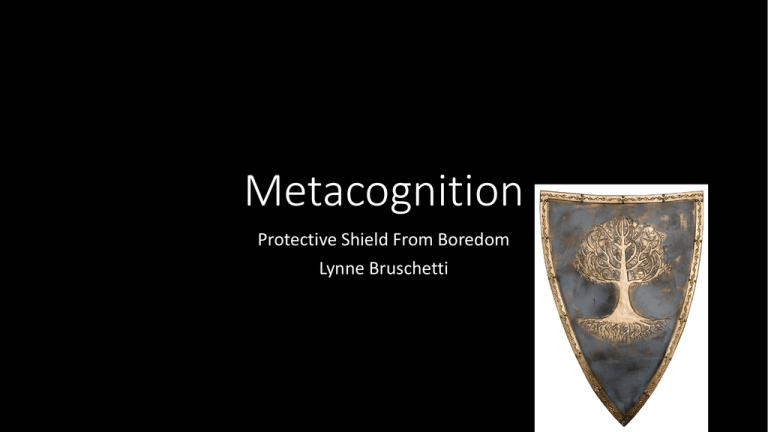
Metacognition Protective Shield From Boredom Lynne Bruschetti Evolution of a Teacher “THINK!” Evolution of a Teacher “I will give you time to think.” Evolution of a Teacher “You now have a graphic organizer to think.” Synectics Six Steps That Must Be Followed Step One Journal entry describing an abstract noun. Step Two Providing analogies. Step Three Make one of the analogies personal. Step Four Provide tension; conflict. Step Five • Students are finally ready to write an original metaphor. Step Six Students compare their new writing with their original definition of an abstract noun. Poetry Students are now ready to look at metaphors written by professional poets and see their inventive comparisons. Thematic Units Students now have an important skill necessary to approach thematic units. Whether reading Fahrenheit 451, Romeo and Juliet, or Lord of the Flies, students will see how metaphors intentionally used help readers understand theme. Oliver Wendell Holmes, Sr. “I would not give a fig for the simplicity on this side of complexity, but I would give my life for the simplicity on the other side of complexity.” Design is highly personal, yet disciplined by a common purpose and a common language. • “Teachers are taught to make rational selections among alternative activities rather than to create new alternatives. They are encouraged to use predetermined formats and structures rather than to think metaphorically, creatively, and reflectively about the work they are trying to get students to do” (Schlechty, 2011, p 50). Synectics • Creating something new. • Making the strange familiar. Models of Teaching Bruce Joyce, Marsha Weil, and Emily Calhoun • “Synectics is designed to increase the creativity of both individuals and groups. Sharing the synectics experience can build a feeling of community among students” (Joyce, Weil, & Calhoun ,2004, p. 177). Creative Writing Exploring Social Problems Problem Solving Creating a Design or Product Broadening Perspective of an Abstract Concept Phase I: Description of the Present Condition • Teacher has students describe the situation or topic as they see it now. • I Forgot My Phone - YouTube Phase Two: Direct Analogy • Students suggest direct analogies, select one, and explore (describe) it further. How is a cell phone like a bathtub? How is it like a book? How is it like ballroom dancing? How is it like a pair of scissors? Phase Three: Personal Analogy • Students “become” the analogy they selected in phase two. Be the cell phone in the video. You’re at the attempted marriage proposal. You’re at the birthday party. You’re with your owner when he goes to bed. How do you feel? Phase Four: Compressed Conflict • Students take their descriptions from phases two and three, suggest several compressed conflicts (oxymorons), and choose one. Phase Five: Direct Analogy • Students generate and select another direct analogy, based on the compressed conflict (analogy). Phase Six: Reexamination of the Original Task • Teacher has students move back to original task or problem and use the last analogy and/or the entire synectics experience. • (Sanders & Sanders, 1984). • Write a paragraph about the use of cell phones, So what can we learn from Socrates? Socrates used synectics. Synectics • Socrates compared himself to a gadfly, the horsefly that stings the intellectually and morally sluggish citizens of Athens with his questioning. Synectics • “Good teaching traditionally makes ingenious use of analogies and metaphors to help students visualize content” (Gordon, 1961). Synectics • “My art of midwifery is in general like theirs [real midwives]; the only difference is that my patients are men, not women, and my concern is not with the body but with the soul that is in travail of birth.” Synectics • “And the highest point of my art is the power to prove by every test whether the offspring of a young man’s thought is a false phantom or instinct with life and truth.” Synectics • “Those who frequent my company at first appear, some of them, quite unintelligent, but, as we go further with our discussions, all who are favored by heaven make progress at a rate that seems surprising to others as well as themselves, although it is clear that they have never learned anything from me.” Synectics • The many admirable truths they bring to birth have been discovered by themselves from within. And the delivery is heaven’s works and mine.” So what can we learn from Socrates? Barry Schwartz • A wise person is made and not born. Works Cited • de Botton, A. (2000). The consolations of philosophy. New York: Vintage. • Gladwell, M. (2010). Outliers: The story of success. New York: Back Bay Books. • Gordan, W. J .J. (1961). Synectics: The development of creative capacity. New York: Harper & Row Publishers, Inc. • Joyce B., Weil M., & Calhoun, E. (2004). Models of teaching. Boston: Pearson. • Sanders, D. A., & J. A. (1984). Teaching creativity through metaphor. New York: Longman. • Schlechty, Phillip C. (2011). Engaging students. San Francisco, Jossey-Bass.
